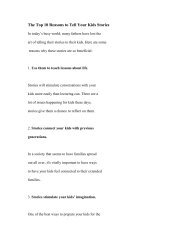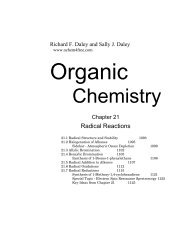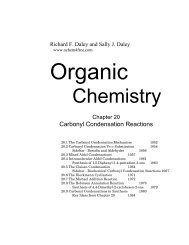Organic Chemistry
Chirality
Chirality
Create successful ePaper yourself
Turn your PDF publications into a flip-book with our unique Google optimized e-Paper software.
<strong>Organic</strong> <strong>Chemistry</strong> - Ch 11 562 Daley & DaleyCOOHHHOOHHCOOH(+)-Tartaric acidFigure 11.9 shows the esterification reaction of the resultingdiastereomeric esters. Because diastereomers generally have differentphysical properties, they can be separated easily via distillation,chromatography, crystallization, or other physical methods. Forexample, the two diastereomeric esters of tartaric acid have meltingpoints that differ by about 20 o C. They also have different watersolubilities and different acid strengths. These differences allowseparation using ordinary physical methods. The separation is socomplete that you end up with each of the diastereomeric esters in thepure form.OCH 3HCOHOCH 3HCOOHHHOOHHCH 2 CH 3HCH 2 CH 3CH 3OHCH 2 CH 3+H OH HHO HCOOHHCOOH(R)-2-Butyl (+)-tartrateCH 3 OO CRacemic 2-butanol(+)-Tartaric acidCH 2 CH 3HOHHOHCOOH(S)-2-Butyl (+)-tartrateFigure 11.9. Reaction of (R)- and (S)-2-butanol with (+)-tartaric acid to produce (R)-and (S)-2-butyl (+)-tartrate. The two diastereomeric esters of tartaric acid can beseparated because they have different physical properties.A hydrolysis reaction is a good way to isolate the enantiomericalcohols. Hydrolysis of (R)-2-butyl tartrate gives (R)-2-butanol.www.ochem4free.com 5 July 2005







